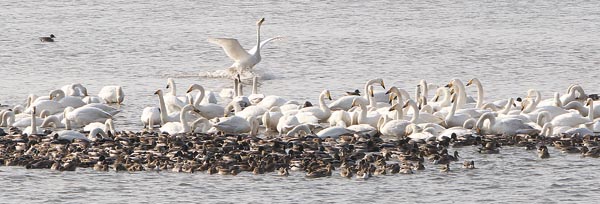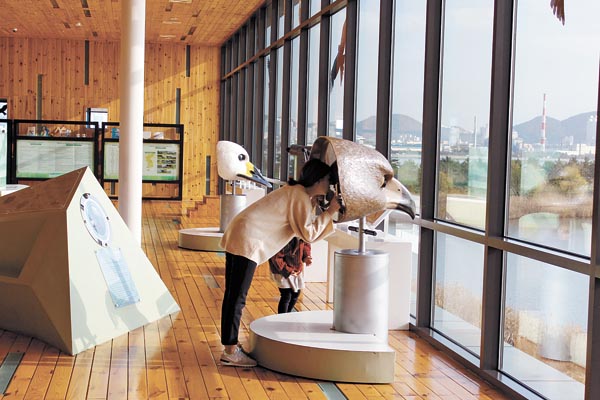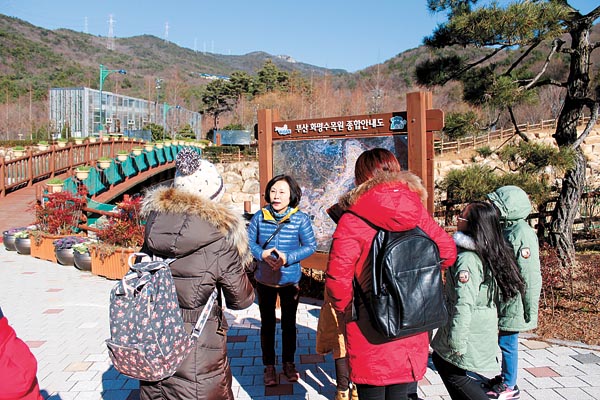Busan has more to offer than trendy beaches

Tundra swans and ducks float on the pond in Eulsuk Island, Busan. The island attracts many migratory birds. [JOONGANG ILBO]
But recently, the Busan Metropolitan Government has been coming up with plans to bring more attention to the less-crowded western part of the city, closer to the Nakdong River and Gimhae International Airport. While the Haeundae area has become a shopping mecca for global luxury brands and hot spot for grandiose hotels, many areas of western Busan have remained underdeveloped and home to industrial factory complexes.

A visitor to the Nakdong Estuary Eco Center looks into a telescope shaped like a bird. [BUSAN TOURISM ORGANIZATION]
“It is about time for us to make better use of the resources available in western Busan,” said Park Jin-woo, marketing manager for the Busan Tourism Organization. “It will take some time to make any drastic change, but the tourism infrastructure will improve in the coming years in a way that attracts more tourists.”

Participants of a tour in western Busan gather at Hwamyeong Arboretum to learn more about the effects of climate change. [BUSAN TOURISM ORGANIZATION]
On the island, the Eulsukdo Ecology Park is filled with tall reeds. There are also many ponds where birds can rest their wings and fill their stomachs. Those looking for excitement might not enjoy a relaxing walk around the park, but the well-paved trails have been popular among couples on dates and friends looking for some quiet time together. Bicycles are available for hourly rental, and there is a drive-in theater, so visitors to the island can make a day trip out of it.
While the outdoor park is popular among adults, parents with children can enjoy the Nakdong Estuary Eco Center, according to Son Min-soo, president of Yeohaeng Teukgongdae, the travel agency commissioned to arrange new bus trips in western Busan.
The center is equipped with many interactive information boards to explain the habits of migratory birds. Plus, the large floor-to-ceiling window offering views of a small lake filled with ducks and tundra swans, along with other birds, will catch children’s eyes. Telescopes are available by the window to offer a closer look at the birds, and some are even shaped like the head of a bird.
To build on the experience of the eco center, Son decided to provide visitors with some stories to follow throughout the tour. Prior to visiting the center, tour guides leading the program will explain why the island has lost its place as the largest home for migratory birds in Asia, and elaborate on how climate change played a role in the change.
“Just simply taking visitors from one place to another on a bus and giving them a brief explanation of each spot does not have the power to make a tour program sustainable,” Son said. “It is the job for those in the tourism industry to continue developing new stories and adding to existing resources so that travelers can have a new eye and see the same things differently.”
After spending the day hearing stories about western Busan, visitors are taken to a skywalk at Songdo Beach for some photo opportunities. On the wooden bridge set up in the shallow waters, travelers can pose with the beach or the open sea in the background. Some parts of the bridge are covered with clear glass so that people can feel as if they are walking right over the crashing waves.
For more information about tours in western Busan, call (070) 4651-4113. The tours are available today, tomorrow, Feb. 26 and Feb. 27. Participants gather either at Busan Station or Gupo Station. The price for adults and college students is 20,000 won ($17) and 15,000 won for children and students. For an extra 5,000 won, visitors can take a boat on the Nakdong River. Lunch is provided.
BY LEE SUN-MIN [summerlee@joongang.co.kr]










with the Korea JoongAng Daily
To write comments, please log in to one of the accounts.
Standards Board Policy (0/250자)